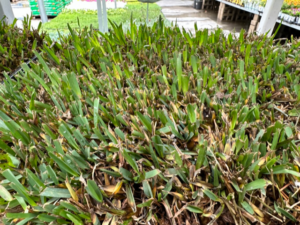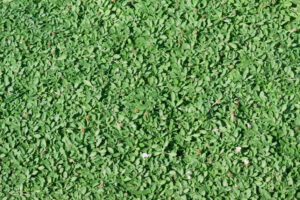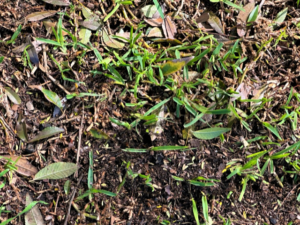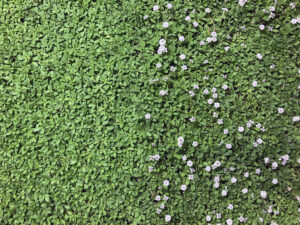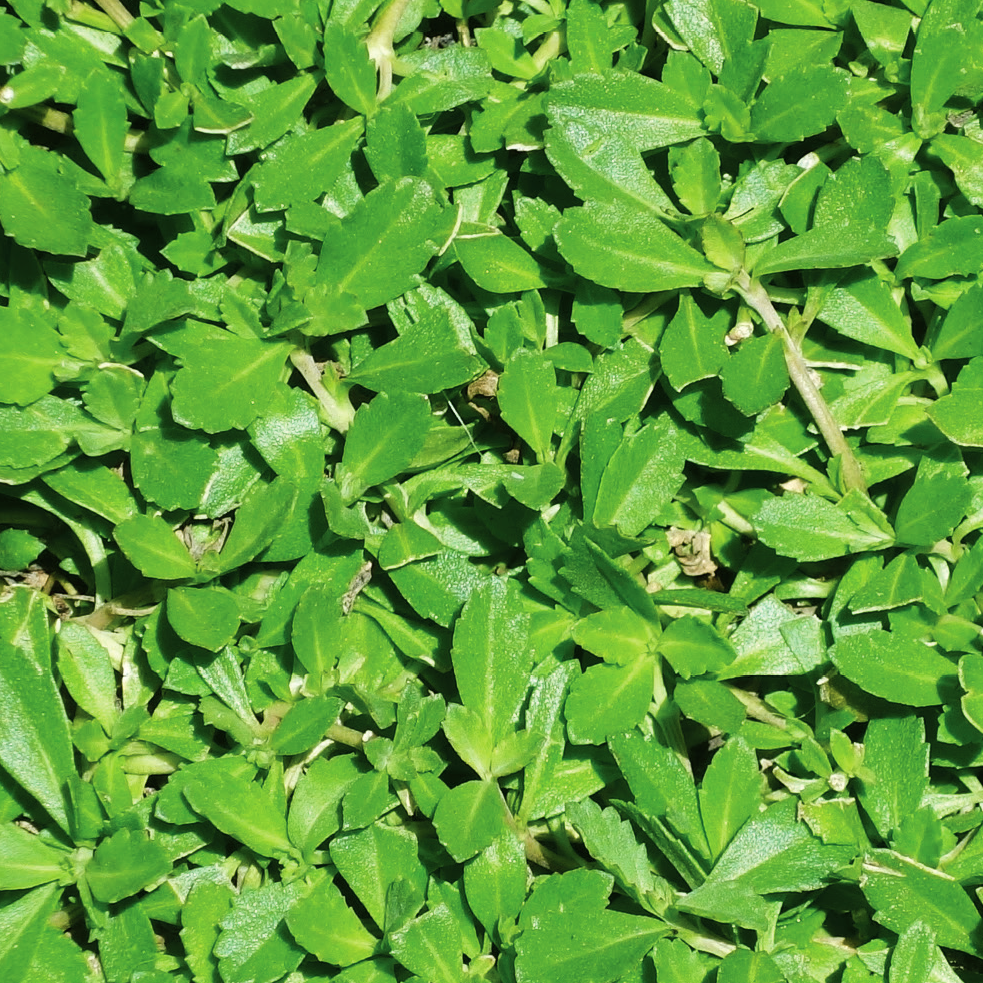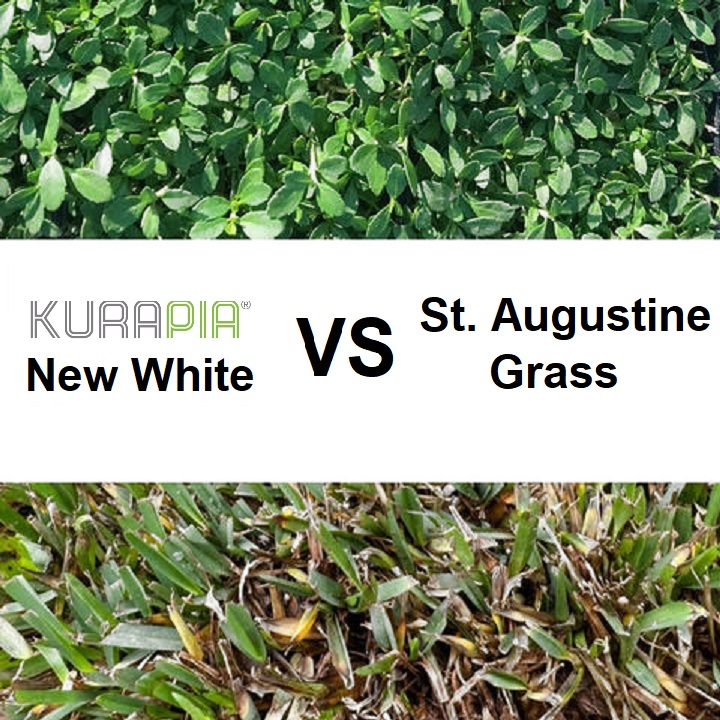
Kurapia vs St. Augustine Grass
Kurapia New White and Kurapia Pink remain the undisputed champs in the world of drought tolerant groundcover and turf. However we are occasionally asked how we compare to St. Augustine Grass. St. Augustine grass is a salt tolerant turf suited for subtropical & humid areas. It is widely grown in warm weather states.
While many sod companies claim that St. Augustine is the best turf for California landscapes, citing its thick blades of grass and stiff appearance as signs of it being an indestructible turf grass. However, those who have switched from St. Augustine (and other grasses) to Kurapia New White, will be the first to tell you, Kurapia is superior in all ways over St. Augustine grass. Let’s compare:
Kurapia New White vs. St. Augustine Grass
Cost:
Installing St. Augustine will be more expensive that Kurapia New White. Factor in the cost and the shipping fees of sod, groundcover flats, or plugs will cost more than Kurapia White. This is just the cost of the plants plus shipping. Once you factor in the cost of frequent mowing, frequent watering, fertilizer, disease and pest control, you’ll find yourself spending quite a bit more for St. Augustine over Kurapia New White or Kurapia Pink. Advantage: Kurapia New White
Water Needs:
Those who advocate for St. Augustine claim it’s drought tolerant. However, experts will be the first to tell you that St. Augustine needs 2-3 waterings a week, maybe even more in the summer, to maintain it’s green leaves and prevent dying. That’s why irrigation is so important for success with this grass, and while areas where the plants aren’t getting at least 1-2 inches of water, with a recommended 6-8 hours of watering a week to get it established. Kurapia New White, however, needs only much much less. We find Kurapia New White plugs work great with low water sprinkler heads like Hunter MP Rotors (one of the most water efficient sprinklers) which slowly soaks the soil deeply. Because the root depth of established St. Augustine seldom goes deeper than a few inches, it’s easy to see why this is needed. Kurapia New White and Pink, on the other hand, grows several feet, some even deeper than nine feet once established. Advantage: Kurapia New White
Drought Tolerance:
St. Augustine is not a drought tolerant plant. If the grass gets less water than needed, especially in the summer but even in the winter, the plants die. After six weeks the grass is completely dead. Other issues such a disease, pests, and mistreatment will also wipe out large sections of St. Augustine, which usually requires the areas to be dug up and replanted. Kurapia has its’ deep roots and leaves, which store excess water and nutrition, to keep an established plant to survive long bouts of no water. In fact, in water deficit trials at UC Riverside, against all the most popular grasses, Kurapia decidedly outlived and survived long after the grasses died off. Advantage: Kurapia New White
Feel:
St. Augustine grows straight up, in thick blades of grass that are course and stiff. Walking on it is irritating to the skin. It’s like standing on top of rows of grass blades. Kurapia grows horizontally, with flat leaves that lay flat on each other. The result is soft and cushiony, almost like a yoga mat. While still heavily durable, Kurapia feels great walked on with bare feet and mowing helps it even get more level and cushiony. Advantage: Kurapia New White
Winterization:
St. Augustine has a dormancy period when it’s cold. The grass blades all die off, leaving behind a thick thatch of dead steps and leaves, inviting winter weeds to sprout. In USDA Climate zones 7B and above, Kurapia New White and Pink stay evergreen, keeping that green lush look year round. Advantage: Kurapia New White
Thatch:
St. Augustine is well known to have thatch build up, which is very unsightly and must be “dethatched” repeatedly to keep the plant from becoming so thick the grass is almost obscured by the heavy mass of dead stems and leaves. Doing so is very labor intensive and makes the grass look dead for awhile. Kurapia is a self-regenerating plant that doesn’t have this limitation. Only after a few years in a place where it’s happy is Kurapia ever really needed any special treatment outside of mowing, and such tasks are easy to achieve, such as core aeration. Advantage: Kurapia New White
Mowing:
This is where we start to see why customers who have replaced their lawns with Kurapia New White have never looked back. Experts recommend you mow St. Augustine every week to keep it from growing too thick, needing more water, and increasing the height of the thatch. Kurapia recommends monthly mowing optionally in the warm season just to keep it compact. Kurapia New White can be left unmowed, and in full sun tends to just look “fluffy” but stays low. Advantage: Kurapia New White
Fertilization:
Since St. Augustine grass relies on constant upright growth, experts recommend heavy fertilization schedules, which is estimated 1 pound of nitrogen per 1000 square foot every 8 weeks. This ends up with many visits rolling fertilizer droppers or spraying liquid fertilizers on your lawn 4-8 times a year. Kurapia since it stores nutrition in his tissue, only requires two balanced organic fertilizer applications a year (we like using Sea Grow 16-16-16 half strength twice a year in April and September). This not only saves you money, it also cuts down the time and space you need to store all that lawn food. Advantage: Kurapia New White
Disease:
St. Augustine grows fast in the warm season, spring and summer, and this constant watering, fertilizer, and warmth makes a perfect spot for diseases. You’ll find St. Augustine owners have to constantly pretreat and fight stubborn diseases such as gray leaf spot, St. Augustine decline, nigrospora stolon rot, take-all root rot (TARR), and fairy ring. You know your lawn is disease prone when many fertilizers come with dangerous fungicides and there’s actual diseases named after your product. Kurapia disease is rare, usually only brought on when the area is being overwatered or drainage is poor. Advantage: Kurapia New White
Insect Control:
St. Augustine attracts a lot of bugs. Being a that it needs to watered so much, and have such a heavy thatch, it becomes a breeding ground of pests. Chich Bugs is the most common, while fall armyworms, grub worms and sod webworms love St. Augustine thatch, as well as billbugs and crickets. To control these, the products that are recommended can cause stomach distress, nausea, vomiting and must be applied with protection to not get it on your skin. Kurapia since it grows low and doesn’t produce a thatch, insects are incredibly rare. Advantage: Kurapia New White
Environmental Impact:
This is obvious. Kurapia New White requires less water, less fertilizer, less fungicides, less insecticides, less herbicides, less maintenance, and less mowing. This means less fossil fuels needed for that fertilizer and lawn mowers. In fact, Kurapia New White captures more carbon that grasses since it locks it away in the soil longer. Advantage: Kurapia New White
Summary
We at Kurapia.com absolutely want to be sure you have the most accurate information and the best plants for your yard, and we love to support our hundreds of satisfied customers. Come shop with us or run our handy-dandy calculator and see how many Kurapia plants we recommend for your yard.
Thank You!
Thank you for visiting Kurapia.com, the ultimate drought tolerant groundcover and lawn alternative.


